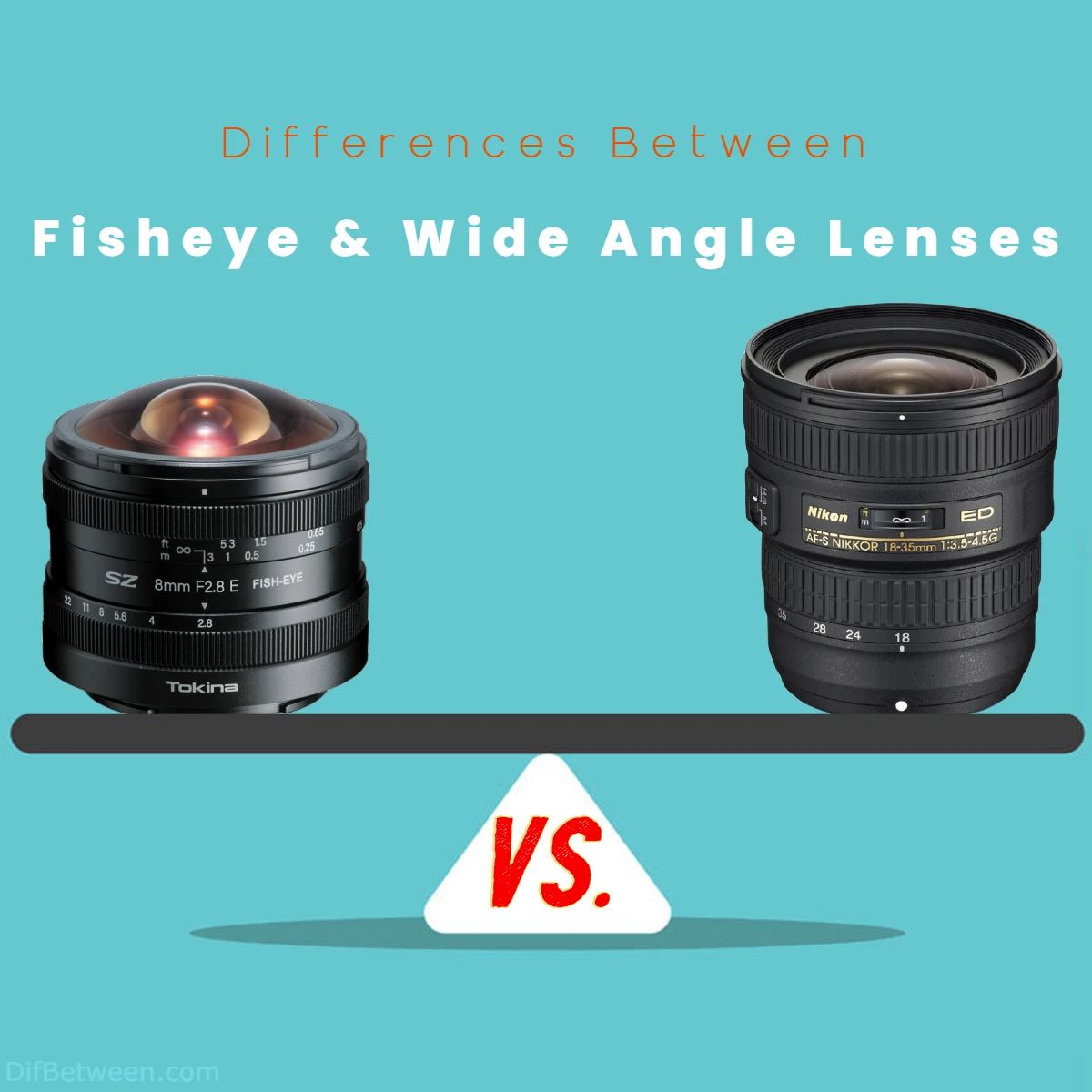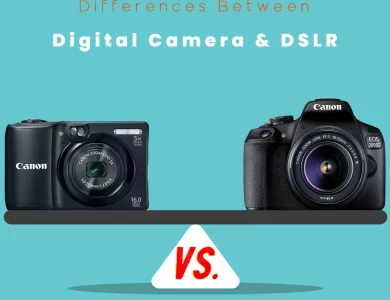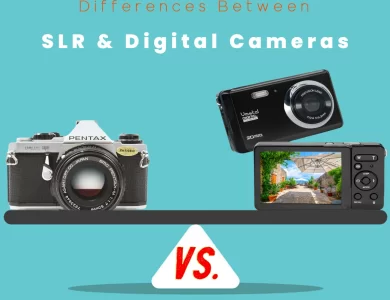
| Aspect | Wide Angle Lens | Fisheye Lens |
|---|---|---|
| Field of View | Wide, but less extreme than fisheye | Extremely wide, often exceeding 180 degrees |
| Distortion | Moderate distortion with relatively straight lines | Severe barrel distortion, warping and bending of lines |
| Projection Type | Rectilinear projection, maintains straight lines | Curvilinear projection, distorts lines outward |
| Image Coverage | Rectangular frame, maintains realistic proportions | Circular or full-frame curved image |
| Depth and Visual Impact | Emphasizes depth through foreground elements | Manipulates depth with exaggerated curvature |
| Practicality | Versatile, suitable for various genres | Distinctive, suited for artistic and experimental shots |
| Realism vs. Artistry | Balances realism and creative expression | Embraces distortion for artistic impact |
| Suitable For | Landscapes, architecture, interiors, portraits | Experimental photography, capturing dynamic scenes |
| Proportion Maintenance | Maintains relatively accurate proportions | Intentionally distorts proportions for creative effect |
| Post-Processing | Moderate distortion can be corrected | Distortion is a defining feature, less correctable |
| Visual Storytelling | Creates expansive scenes with depth | Turns scenes into surreal narratives |
| Applicability | Wide range of scenarios and subjects | Specialized for specific creative visions |
| Impact on Viewer | Realistic portrayal of scenes | Challenges perceptions and evokes emotions |
While both lenses serve to capture expansive scenes, they do so with their own unique characteristics, creating distinct visual effects that can dramatically impact your photography. So, let’s embark on this visual journey and uncover the key differences between these two lens marvels.
Differences Between Wide Angle and Fisheye Lenses
The main differences between a Wide Angle Lens and a Fisheye Lens lie in their field of view and distortion effects. A Wide Angle Lens offers a wide yet more realistic field of view, ideal for capturing expansive landscapes and architectural details with moderate distortion. On the other hand, a Fisheye Lens boasts an extremely wide field of view exceeding 180 degrees, accompanied by intense barrel distortion that creatively warps and stretches scenes. While Wide Angle Lenses maintain a balance between realism and creative expression, Fisheye Lenses embrace extreme distortion for artistic impact, transforming ordinary scenes into visually captivating and surreal compositions.
Perspective and Field of View
When it comes to capturing breathtaking landscapes or cramming in a bustling cityscape, the wide angle lens takes the spotlight. This lens boasts a wider field of view, allowing you to fit more of the scene into your frame without the pronounced distortion that a fisheye lens might introduce. The focal lengths of wide angle lenses typically range from around 14mm to 35mm, making them perfect for capturing sweeping vistas, architecture, and group portraits. With a wide angle lens, you can emphasize depth and create a sense of grandeur in your shots, making your audience feel like they’re standing right there in the moment.
On the flip side, we have the fisheye lens, a lens known for its characteristic barrel distortion and exaggerated, almost surreal, perspective. Fisheye lenses possess an exceptionally wide field of view, often exceeding 180 degrees. This extreme distortion is what sets them apart from other lenses. They are often categorized into two types: circular fisheye lenses and full-frame fisheye lenses. Circular fisheye lenses produce a circular image within the frame, while full-frame fisheye lenses cover the entire frame, creating a distinctive curved effect. Fisheye lenses are favored by photographers aiming to push creative boundaries and capture unique, quirky images that bend reality in captivating ways.
Distortion: Subtle vs. Extreme
One of the most noticeable differences between wide angle and fisheye lenses lies in the degree of distortion they introduce to your photographs.
Wide angle lenses, though they do exhibit some distortion, tend to keep lines relatively straight, maintaining a semblance of realism. This makes them an excellent choice for architectural photography, where maintaining the structural integrity of buildings and lines is essential. Wide angle lenses can correct distortion to a certain extent, but a slight degree of distortion can often lend a dynamic and energetic feel to your images, amplifying the visual impact.
In contrast, the hallmark of the fisheye lens is its intentional distortion. The barrel distortion creates a distinct bulging effect, warping straight lines and bending the image towards the edges. This distortion can be creatively employed to produce images that appear dreamlike or surreal. Objects at the center of the frame remain relatively normal, while those at the edges are stretched and curved. Fisheye lenses can add a whimsical and fantastical touch to your shots, allowing you to reshape reality according to your creative vision.
| Wide Angle Lens | Fisheye Lens | |
|---|---|---|
| Field of View | Wide, but less extreme | Extremely wide, often exceeding 180 degrees |
| Distortion | Moderate distortion, with straight lines maintained to some extent | Severe barrel distortion, warping and bending of lines |
Image Coverage: Rectilinear vs. Circular
The difference in how wide angle and fisheye lenses project the scene onto your camera’s sensor or film is a fundamental factor that sets these two lens types apart.
Wide angle lenses use a rectilinear projection. This means that straight lines in the real world remain straight in the image produced by the lens. This projection is more true-to-life and maintains the proportions of objects in the frame. It’s well-suited for situations where maintaining realistic proportions is crucial, such as architectural photography or capturing landscapes with prominent linear elements like roads and buildings.
On the other hand, the fisheye lens employs a curvilinear projection. This projection bends straight lines outward, creating the signature barrel distortion. Circular fisheye lenses project a circular image within the frame, while full-frame fisheye lenses spread the circular image to cover the entire rectangular frame. This projection intentionally distorts the image, giving it a unique and often surreal appearance. The curvilinear projection of fisheye lenses is a defining feature that appeals to photographers seeking a more experimental and artistic perspective.
Depth and Visual Impact
The way lenses handle depth and the resulting visual impact on your images can greatly influence the storytelling and emotional resonance of your photographs.
With a wide angle lens, you have the power to accentuate depth in your shots. By incorporating foreground elements into your composition, you can create a sense of dimension and immersion that draws your viewers into the scene. Wide angle lenses excel at capturing expansive landscapes, where the layers of distance are integral to the overall storytelling. Additionally, when photographing architecture or interiors, wide angle lenses help convey a feeling of spaciousness and openness, making the viewer feel like they’re physically present in the space.
Conversely, fisheye lenses introduce a distinctive depth manipulation that can be both playful and disorienting. The exaggerated curvature of the image can make close subjects appear gigantic, while those at the periphery seem distant and almost warped. This depth manipulation can be harnessed creatively to evoke emotions or emphasize certain elements within your composition. Photographers often utilize fisheye lenses for dynamic action shots or to create images that challenge the viewer’s perception of space and reality.
| Wide Angle Lens | Fisheye Lens | |
|---|---|---|
| Image Depth | Emphasizes depth through foreground elements and layering | Manipulates depth with exaggerated curvature, altering size relationships |
Practical Considerations: Versatility vs. Distinctiveness
When choosing between a wide angle lens and a fisheye lens, it’s essential to consider the practical implications of each lens type and how they align with your photographic goals.
Wide angle lenses are celebrated for their versatility. They’re a staple in many photographers’ kits due to their ability to handle a wide range of scenarios, from landscapes to architecture to portraits. The moderate distortion introduced by wide angle lenses can often be corrected in post-processing, giving you a balance between creative expression and realism. If you’re looking for a lens that can adapt to various situations while maintaining a natural perspective, a wide angle lens might be your ideal companion.
In contrast, the fisheye lens is all about bold distinctiveness. It’s a creative tool that can instantly transform an ordinary scene into an extraordinary spectacle. Fisheye images stand out due to their unique curvature and surreal effects, making them perfect for experimental photography, artistic expression, or adding a touch of quirkiness to your portfolio. However, the distinctive distortion may limit the applicability of fisheye lenses in certain contexts, such as when accuracy and proportion are paramount.
Wide Angle or Fisheye Lenses: Which One is Right for You?
Choosing between a Wide Angle Lens and a Fisheye Lens ultimately depends on your creative vision, the stories you want to tell, and the impact you want your images to have. Let’s dive into the considerations that can help you make the right choice for your photography journey:
Wide Angle Lens: When to Choose It
- Realism and Versatility: If your photography style leans towards capturing scenes as they are, a Wide Angle Lens might be your go-to choice. These lenses maintain more realistic proportions and lines, making them suitable for genres like landscapes, architecture, interiors, and even portraits.
- Depth and Dimension: If you’re drawn to creating images with a sense of depth and dimension, a Wide Angle Lens excels in incorporating foreground elements and leading the viewer’s eye into the scene. This lens type allows you to emphasize the layers of distance, giving your compositions a dynamic and immersive quality.
- Balanced Creativity: Wide Angle Lenses offer a balance between creative expression and realism. While they introduce some distortion, it’s generally more subtle and correctable in post-processing. This makes them versatile tools for photographers who want to experiment while maintaining a connection to reality.
- Adaptable for Various Genres: Whether you’re capturing sweeping landscapes, cityscapes, or architectural details, Wide Angle Lenses can seamlessly adapt to a range of scenarios. Their ability to capture expansive scenes while preserving a natural perspective makes them reliable companions for different photography styles.
Fisheye Lens: When to Choose It
- Artistic Expression and Experimentation: If you’re a creative at heart and want to challenge conventions, a Fisheye Lens opens the door to imaginative possibilities. These lenses introduce extreme distortion and curvilinear projection, allowing you to create surreal and eye-catching images that push the boundaries of visual storytelling.
- Unconventional Perspectives: Fisheye Lenses excel at capturing scenes from angles that defy expectations. They’re perfect for dynamic shots where you want to introduce a playful and distorted perspective, turning ordinary moments into extraordinary visual narratives.
- Distinctive Visual Impact: If you’re aiming to stand out and leave a lasting impression, a Fisheye Lens can help you achieve just that. Their unique distortion and unconventional aesthetics make your images memorable and thought-provoking, evoking emotions and sparking curiosity.
- Specialized Artistry: Fisheye Lenses are ideal for photographers who want to explore niche artistic expressions. They’re great for capturing events, concerts, and scenes with high energy, as well as for creating abstract compositions that challenge viewers’ perceptions.
Making the Choice
In the end, the choice between a Wide Angle Lens and a Fisheye Lens boils down to your creative intent and the stories you want to convey. Consider the genres you’re passionate about, your desired visual impact, and the level of distortion you’re comfortable with. Remember that both lens types have their unique strengths, and the best choice depends on aligning those strengths with your photographic goals.
Whether you’re looking to capture expansive landscapes with a touch of realism or transport viewers to a realm of artistic distortion, your camera is your canvas, and the lens is your brush. Embrace the magic of photography and choose the lens that resonates with your creative spirit. Happy shooting!
FAQs
The main difference lies in the level of distortion and field of view. Wide Angle Lenses have a wide field of view and moderate distortion, making them suitable for capturing expansive scenes with a more natural perspective. Fisheye Lenses, on the other hand, offer an extremely wide field of view with significant distortion, creating a surreal and artistic effect in images.
Wide Angle Lenses introduce moderate distortion, particularly towards the edges of the frame. However, they aim to maintain relatively straight lines and realistic proportions. Fisheye Lenses, with their barrel distortion, curve and bend lines dramatically outward, creating a distinct visual effect that is both eye-catching and unconventional.
Wide Angle Lens distortion can often be corrected to some extent in post-processing software, striking a balance between creative expression and realism. On the other hand, the distortion caused by Fisheye Lenses is more inherent and challenging to correct completely due to its extreme nature.
Wide Angle Lenses excel in capturing landscapes, architecture, interiors, and even portraits where including foreground elements and maintaining a sense of depth is important. They are also preferred for scenarios where preserving realistic proportions and lines is crucial.
Fisheye Lenses are perfect for experimental and creative photography. They are ideal for capturing dynamic scenes, events, and spaces where you want to introduce a unique and distorted perspective. Fisheye Lenses can add an artistic touch to your images, making them stand out with their unconventional distortion.
Fisheye Lenses are not typically considered mainstream lenses for professional work due to their distinct distortion, which might not be suitable for certain genres like commercial photography or portraiture. However, they can be valuable tools for photographers aiming to explore artistic expression and create unconventional visuals.
Absolutely! Wide Angle Lenses are versatile tools that allow you to capture sweeping landscapes, architecture, and more. They offer the ability to emphasize depth, incorporate foreground elements, and create a sense of grandeur in your compositions. While their distortion is more subtle, it can still be creatively employed to add dynamism to your shots.
While both Wide Angle and Fisheye Lenses capture wide scenes, they offer distinct visual effects. The choice between the two depends on your desired outcome. Wide Angle Lenses offer a more balanced and versatile approach, while Fisheye Lenses are better suited for creating eye-catching, artistic, and distorted visuals.
Wide Angle Lenses are generally preferred for architecture and interior photography. They maintain straight lines and realistic proportions, which is crucial for capturing the accurate details of structures and spaces. Fisheye Lenses, with their extreme distortion, might not be the best choice in these scenarios.
Fisheye Lenses require a different compositional approach due to their pronounced distortion. It’s important to consider how the distortion will affect the overall aesthetic of the image and whether it aligns with your creative intent. Additionally, avoiding subjects at the edges of the frame can help minimize excessive distortion.
Read More:
Contents






